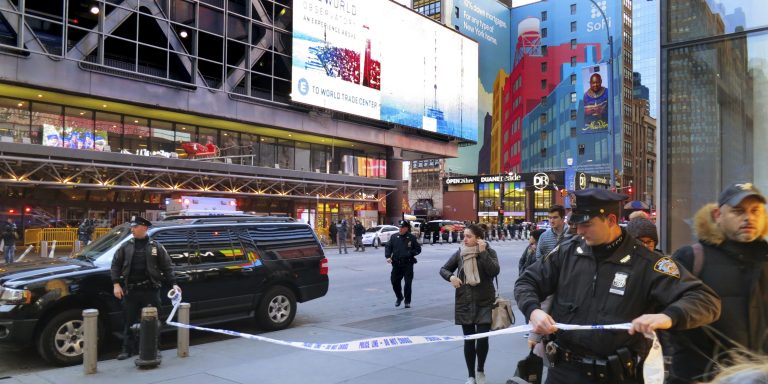INTELBRIEF
December 12, 2017
TSC IntelBrief: Looking at the New York City Pipe Bomb Attack

• On December 11, a man identified as 27-year old Bangladeshi immigrant Akayed Ullah set off a pipe bomb strapped to his chest in a pedestrian tunnel linking New York’s Times Square and Port Authority subway terminals, injuring himself and four others.
• Police characterized the attack as an attempted suicide bombing inspired by the so-called Islamic State, a reminder of the widespread threat posed by the collapsing group.
• Such small-scale attacks are almost impossible to stop, and the casualty count could have been much higher, given the target is one of the most crowded transportation hubs in the U.S.
• New York City remains one of the most targeted cities in the U.S for terrorism, and its mass transit systems, the most targeted sector.
On December 9, Iraqi Prime Minister Haider Al-Abadi declared on his Twitter account that Iraq had ‘fully liberated’ its territory from the so-called Islamic State, through ‘unity and sacrifice for our nation.’ However, despite losing nearly all of its territorial gains made since late 2013, the group continues to be a touchstone for terrorists seeking to kill in its name. On December 11, police say a man identified as 27-year old Bangladeshi immigrant Akayed Ullah tried to commit mass murder in the name of the Islamic State, striking at the heart of New York City’s mass transit system. The difference between a horrific mass casualty attack and a sobering reminder of how persistent the threat is, and likely will remain, appears to have come down to an ineffectively detonated pipe bomb and luck.
Police say Ullah told investigators he made the small pipe bomb at his workplace and intentionally detonated it among the pedestrians in walkways in linking the Times Square and Port Authority bus terminal subway stations. Investigators say he chose the target because it was decorated with posters celebrating Christmas and that he claimed the attack was retaliation for U.S. airstrikes against the Islamic State. According to police reports, Ullah strapped the pipe bomb to his stomach, using wire ties and Velcro. He was severely wounded in the detonation; three bystanders also suffered minor injuries. Ullah was quickly arrested, sent to Bellevue hospital for treatment and will be charged and prosecuted by the office of the United States attorney for the Southern District of New York.
The bombing was a near miss for a city that faces constant credible threats of terrorism. Attacks of this nature require little planning of the type that can raise alarms among counterterrorism professionals. It’s become one of the hallmarks of modern terror: small plots involving one, or perhaps a handful of suspects, with warning signs that are obvious only in hindsight. The Joint Terrorism Task Force (JTTF) in New York, like the other JTTF throughout the U.S., are working nonstop to detect, deter, and disrupt attack planning across the whole spectrum of possible incidents, ranging from Paris-style coordinated multi-location assaults to one man with a pipe bomb strapped to his chest. The current system does have its flaws—information sharing tends to be an issue as it moves down to the level of local police, who will have to confront the threats if they’re not detected first, However, given the level of threat facing the U.S., the country’s domestic counterterrorism system has been remarkably successful.
That being said, terror attacks on U.S. targets do happen and will happen again. According to George Washington University’s Program on Extremism (GWUPOE), there have been 17 jihadist terror attacks—that is, attacks inspired by the ideology of bin Ladenism—in the U.S. since June 2014, with more than two-thirds of them coming from U.S. citizens. Only France has seen more similar attacks in that time period. The U.S. has also had many more attempted attacks that were disrupted before they could be launched.
The Islamic State's online reaction to the pipe bomb attack, on Twitter and Telegram, was somewhat triumphant, with supporters claiming it was a huge blow against the U.S. As a group, the Islamic State is collapsing back to a still-potent cell-based terrorist organization in Syria and Iraq—as well as states and territories including Afghanistan, the Philippines and western Africa. Its online supporters will seize on any attack, however small, as proof the Islamic State still exists in the twisted thoughts of many people around the world. From a counterterrorism standpoint, attacks such as this are extremely problematic, given the difficulty in detecting such a small plot with few if any indicators to pop up on an already overloaded terror threat matrix. For supporters of the Islamic State and al-Qaeda—mainly due to the wall-to-wall media coverage even the smallest plots create—there is no such thing as a failed terrorist attack. For the U.S., it is vital to build resistance to such attacks, while in no way tolerating them. The quick and focused response to this latest attack by New York City's police, fire and emergency personnel, along with federal officials, is an example of how to properly react to such events, of which more are certain for the foreseeable future.
For tailored research and analysis, please contact: info@thesoufancenter.org
.
.